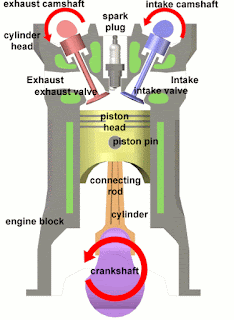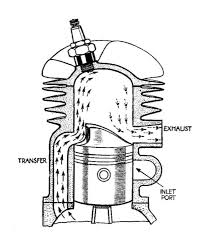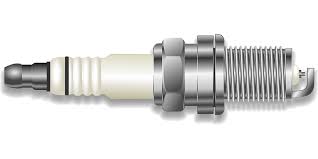IC ENGINE ( INTERNAL COMBUSTION ENGINE)
Table of Contents
Introduction
The engine in which the combustion of fuel takes place inside the engine cylinder are called Internal combustion engine (I.C. engine).Here combustion itself gives power output.The working pressure and temperature inside the cylinder of an I.C. engine is very high.
The efficiency of I.C. engine is about 35- 40 percent.
e.g. petrol engine, diesel engine, gasoline engine.
Sequence of operations in a cycle
Strictly speaking,when an engine is working continuously,we may consider a cycle starting from any stroke.We know that when the engine returns back to the stroke where it started,we say that one cycle has completed.
The following sequence of operation in a cycle is widely used-
1.) Suction stroke-
In this stroke,the fuel vapour in correct proportion is supplied to the engine cylinder.
2.) Compression stroke-
In this stroke,the fuel vapour is compressed in the engine cylinder.
3.) Working or expansion stroke-
In this stroke,the fuel vapour is fired just before the compression is complete.It results in the sudden rise of pressure due to the expansion of the combustion products in the engine cylinder.This sudden rise of pressure pushes the piston with a great force and rotates the crankshaft.The crankshaft in turn drives the machine connected to it.
4.) Exhaust stroke-
In this stroke,the burnt gases or combustion products are exhausted from the engine cylinder.so as to make space available for the fresh fuel vapour.
I.C. engine is mainly of two types.
A.} 2 stroke cycle engine
B.} 4 stroke cycle engine
Difference between 2 stroke and 4 stroke cycle engine
1.) In a 2 stroke engine,the working cycle is completed in two strokes of the piston or one revolution of the crankshaft.
While in a 4 stroke engine,the working cycle is completed in four strokes of the piston or two revolutions of the crankshaft.
2.) 4 stroke engine contains valve like inlet valve and outlet or exhaust valve.
While 2 strokes engine contains ports like inlet port, transfer port and exhaust port.
3.) Power produce is more in 2 stroke engine.
While less power is produce in 4 stroke engine.
4.) There is no fuel loss in 4 stroke engine.
While fuel is lost during exhaust stroke by scavenging in 2 stroke engine.
5.) 4 stroke engines are used where efficiency is important.
While 2 stroke engines are used where power is important.
6.) Working cycle in 2 stroke engine is N.
While working stroke in 4 stroke engine is N/2.
7.) Examples of 4 stroke engine is bike, car, auto,bus,truck etc.
While motor boat,ships are example of 2 stroke engine.
4 stroke petrol engine
2 stroke engine
Now let’s see the difference between petrol engine and diesel engine-
1.) Petrol engine draws both air and fuel during suction stroke.
While diesel engine draws only air during suction.
2.) In petrol engine,a spark plug is used for ignition.
While in diesel engine ignition is done by compression only.
3.) Petrol engine also known as spark ignition (S.I.) engine.
Diesel engine is known as compression ignition (C.I.) engine.
4.) Petrol engine is also known as constant volume cycle.
While Diesel engine is known as constant pressure cycle.
5.) Petrol engine is a quantity based mechanism.
While diesel engine is a quality based mechanism.
6.) In petrol engine combustion is homogeneous.
While in diesel engine combustion is heterogeneous.
7.) Petrol engine is used where high speed and low power required.
While diesel engine is used where low speed and high power required.
8.) In petrol engine the pressure at the end of the compression is about 10 bar.
While in diesel engine the pressure at the end of the compression is about 35 bar.
9.) A petrol engine has compression ratio approximately from 6 to 10.
While a diesel engine has compression ratio from 15 to 20.
10.) Calorific value of Petrol engine is about 45.5 MJ/ kg.
While calorific value of diesel engine is about 45.8 MJ/ kg.
11.) The maintenance cost of petrol engine is less as compare to diesel engine.
12.) Thermal efficiency of petrol engine is about 28%.
While thermal efficiency of diesel engine is about 40%.
13.) Petrol engines are generally employed in light duty vehicles such as scooters,bikes, cars etc.These are also used in aeroplanes.
While diesel engines are generally employed in heavy duty vehicles such as buses, trucks, earth moving machines.
Scavenging of I.C. engines
The process of removing the burnt gases from the combustion chamber of engine cylinder is called scavenging in I.C. engine.
Though there are many types of scavenging process,yet the following are important from subject point of view.
1.) Cross flow scavenging-
In this method,the transfer port( or inlet port for the engine cylinder) and exhaust port are situated on the opposite sides of the engine cylinder ( as in case of two stroke cycle engines).
2.) Back flow or loop scavenging-
In this method,the inlet and outlet ports are situated on the same side of the engine cylinder.
3.) Uniflow scavenging-
In this method,the fresh charge while entering from one side (sometimes two sides) of the engine cylinder pushes out the gases through the exit valve situated at the top of the cylinder.
Supercharging of I.C. engine
It is the process of increasing the mass (or in other words density) of the air fuel mixture ( in S.I. engine) or air (in C.I. engine) induced into the engine cylinder.
This is usually done with the help of a compressor or blower known as supercharger.
It has been experimentally found that the supercharging increases the power developed by the engine.
It is widely used in aircraft engines,as the mass of air sucked in the engine cylinder decreases at very high altitudes.This happens because atmospheric pressure decreases with the increase in altitude.
Following are the objects of supercharging in I.C. engines:
1.) To reduce mass of engine per brake power ( as required in aircraft engines).
2.) To maintain power of aircraft engines at high altitudes where less oxygen is available for combustion.
3.) To reduce space occupied by the engine
(as required in marine engines).
4.) To reduce consumption of lubricating oil.
5.) To increase the power output of an engine when greater power is required ( as required in racing cars).
Lubrication of I.C. engine
Lubrication means to smoothen the machine parts with some agents.
The lubrication of I.C. engine has the following advantages:
1.) It reduces wear and tear of the moving parts.
2.) It damps down the vibrations of the engine.
3.) It dissipates the heat generated from the moving parts due to friction.
4.) It cleans the moving parts.
5.) It makes the piston gas tight.
Governing of I.C. engines
The process of providing any arrangement, which will keep the engine speed constant
(according to changing load conditions) is known as governing of I.C. engines.
Though there are many different methods of governing of I.C. engines,we will discuss most important of them.
1.) Hit and miss governing-
In this system of governing,whenever the engine starts running at higher speed ( due to decreased load),some explosions are omitted or missed.This is done with the help of centrifugal governor.This method of governing is widely used of I.C. engines of smaller capacity or gas engines.
2.) Qualitative governing-
In this system of governing,a control valve is fitted in the fuel delivery pipe, which control the quantity of fuel to be mixed in the charge.The movement of control valve is regulated by the centrifugal governor through rack and pinion arrangement.
3.) Quantitative governing-
In this system of governing,the quality of charge (i.e. air fuel ratio of mixture) is kept constant.But the quantity of mixture supplied to the engine cylinder is varied by means of a throttle valve which is regulated by the centrifugal governor through rack and pinion arrangement.
4.) Combination system of governing-
In this system of governing,the qualitative and quantitative methods of governing are combined together.
Carburettor
Carburettor is only used in S.I. engine or petrol engine.
The carburettor is device for atomising and vaporising the fuel and mixing it with the air in the varying proportions to suit the changing operating conditions of the engine.
The process of breaking up and mixing the fuel with the air is called ‘carburetion’.
*Atomisation is the mechanical breaking up of the liquid fuel into small particles so that every minute particle of the fuel is surrounded by air.
* Vaporisation is a change of state of fuel from a liquid to vapour.
Spark plug
It is also used only in petrol engines.
A spark plug is a device used to produce spark for igniting the charge of petrol engines.
It is always screwed into the cylinder head.
It is usually designed to withstand a pressure upto 35 bars and operate under a current of 10,000 to 30,0000 volts.
The spark plug is kept from 0.3 to 0.7 mm.
Detonation in I.C. engines
The loud pulsating noise heard within the engine cylinder of an I.C. engine is known as detonation.It is also known as knocking or pinking.
It is caused due to propagation of high speed pressure wave created by the auto- ignition of end of unburnt fuel.The blow of this Pressure wave may be of sufficient strength to break the piston.
Thus the detonation is harmful to the engine and must be avoided.
The following are certain factors which causes detonation:
1.) The shape of combustion chamber.
2.) The relative position of the sparking plugs in case of petrol engines.
3.) The chemical nature of the fuel.
4.) The initial temperature and pressure of the fuel.
5.) The rate of combustion of that portion of that fuel which is the first to ignite. This portion of the fuel in heating up, compresses the remaining unburnt fuel, thus producing the conditions for auto- ignition to occur.
NOTE- The detonation in petrol engines can be suppressed or reduced by the addition of small amount of lead ethide or ethyle fluid to the fuel.This is called doping.
The following are the chief effects due to detonation:
1.) A loud pulsating noise which may be accompanied by a vibration of the engine.
2.) An increase in the heat lost to the surface of the combustion chamber.
3.) An increase in carbon deposits.
That was all about the detailed explanation about internal combustion engine. Hope you all like this article. If this was helpful to you then share this article with your well wishers. If you have any doubts regarding this or any mechanical engineering topics then let us know in comment section or contact us through email.
Some images used in mechanical talks is taken from the licensed photo section of Google. We are not taking any kind of credit for all those images



